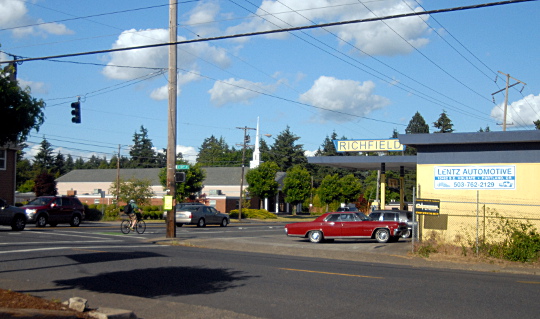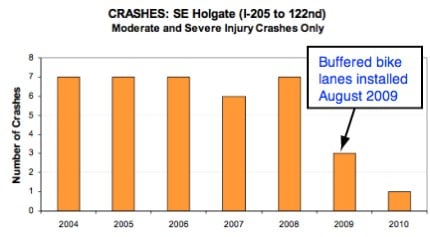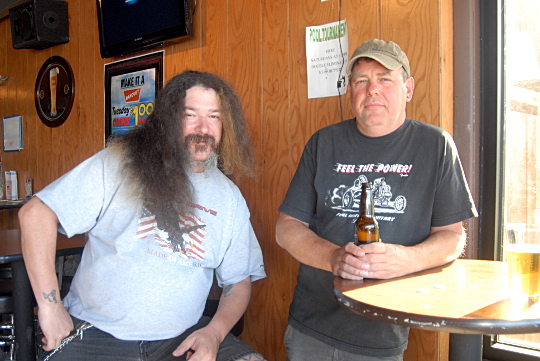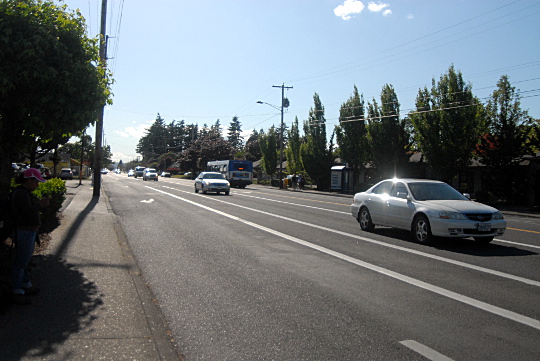
This post is part of our special, week-long focus on east Portland.
It was one of the boulders that broke Portland’s bike wave: a redesign of SE Holgate Street that converted one mixed traffic lane in each direction to a huge buffered bike lane between I-205 and 122nd Avenue.
“Get rid of ‘em. We need the traffic… it sure makes it a pain in the butt to get in and out of businesses.”
— Doug Lentz, Lentz Automotive
KATU-TV branded it a “bike lane to nowhere,” quoting the area’s postal delivery worker. “I bought my property on a four-lane highway,” David Lentz of Lentz Automotive told the station. “I rely on traffic flow.” Down the street at Pro Hair and Nails, owner Kim Lynn told KATU that she’d lost a third of her business after the road diet.
Almost 200 people, most angry at the city for not consulting locals before doing the project, packed Holgate Baptist Church for a meeting with city staff.
The lanes survived. But in the office of Mayor Sam Adams, “Holgate” became, for years, a one-word shorthand for what happens when you push bike amenities down the throat of a neighborhood that “isn’t ready” for them.
Meanwhile, Holgate was also becoming a dramatically safer street, mostly because going down to a single auto lane in each direction had dramatically reduced the number of people driving more than 10 mph over the 35 mph speed limit. Extreme speeding fell by 79 percent eastbound and 30 percent westbound. Moderate and severe crashes plummeted 86 percent more or less immediately.

From November 2008 to November 2010, meanwhile, city traffic counts show that auto traffic on Holgate fell 11 percent in one direction, 16 percent in the other. (It’s not clear how much this was related to the recession; U.S. job losses peaked in January 2009.) Typical traffic speeds didn’t change; TriMet buses reported 15 seconds of delay and the usual 85th percentile speed on the street stayed at 40 mph.
Bike traffic has probably risen slightly. In about half an hour walking around Holgate and 104th between 4:30 and 6 pm, I noticed about 10 bikes using the lanes.
On our 122nd Avenue ride last Sunday, Planning Commissioner (and bike infrastructure fan) Chris Smith said that in his view, the bigger problem had been that the Holgate project was so cheap — just $30,000 — that the city hadn’t bothered to give it a significant budget for community outreach, the series of meetings that can address concerns, defuse anger and build consensus.
Five years later, we wanted to know what Holgate Street’s users think, too. Here’s what they told us.

Doug Lentz still hates the bike lanes.
“Get rid of ’em,” he said. “We need the traffic.”
Lentz, the brother of Lentz Automotive owner David Lentz and an employee at the auto body shop, said the traffic had been cut in half and that there had been “several more accidents out here since the bike lanes came in.”
I asked if he was sure traffic on the street had really halved.
“It might not be half, but it sure makes it a pain in the butt to get in and out of businesses,” he said.
During rush hour, I noticed, traffic is indeed thick enough that it’d take a while to turn left onto Holgate from a side street or driveway.
Advertisement
Lentz is also troubled by the number of people he sees biking in the wrong direction in the new lanes. In my short time there, I saw four people doing this — one of them only briefly because he’d taken advantage of a gap in traffic to turn left, the others simply not bothering to cross the street.
Lentz feels people are “not held accountable for anything” when they’re riding bicycles.
“They could total the side of a car out here and go right away,” he said, referring to the cars parked in front of the auto body shop.
I asked if he was aware of a time when this had happened.
“They ride on the sidewalk, getting too close to really nice cars out here,” he said. “I’m sure they have damaged them.”
Finally, I asked Lentz about the shop’s business.
“We’re pretty busy,” he said. “We’ve always been busy. Lentz has been here 20 years. Longtime customers and word of mouth counts for something. If we relied on solely off-street business, we probably wouldn’t have made it. I don’t know that a new business would have survived if they’d started five years ago here.”

I walked down the street from Lentz to Pro Hair and Nails, still open but with no customers at the moment I walked in, midafternoon Thursday. A woman there politely said she didn’t want to talk to reporters.
“They’re like, ‘Stop spending your money on bike paths. Well, I’m like, ‘Stop polluting your frickin’ city.’”
— Steve Williams, local resident
Next door to the hair salon was Time Out Deli and Pub, which seems to be the only business on Holgate with a bike parking rack: one staple installed right against the wall. When I arrived Tuesday at 5 pm, two bikes were locked to it. Inside, I heard a very different story about Holgate’s buffered bike lane.
“I use it all the time,” said Jasz Morgen, drinking beer at the bar.
Morgen, who lives in the Lents neighborhood, said he owns a car but gets around mostly by bike because, as he said, “I drink.” He said he likes riding the Springwater Corridor and would prefer to see money on crossing improvements there, but that Holgate is at least a better place to ride than 122nd.
Sitting beside Morgen, Steve Williams of Powellhurst also said the bike lane was a major improvement to Holgate.
“They’re doing their best to make improvements, you know,” said Williams, 52, who used to commute by bike and still rides. “It’s getting better out here.”
Williams said he’d happily vote for a $12-a-month street fee to improve transportation maintenance and safety — “that’s three drinks,” he said, gesturing to his beer — and doesn’t agree with critics of bike projects. “They’re like, ‘Stop spending your money on bike paths,'” he said. “Well, I’m like, ‘Stop polluting your frickin’ city.'”

When I stopped by Time Out again on Thursday afternoon, two different people at the bar had similar things to say.
“The concept is excellent,” said a man named Matthew who wouldn’t give his last name. “Five stars. It’s the only thing Sam Adams did that makes sense down the line.”
“Five stars. It’s the only thing Sam Adams did that makes sense down the line.”
But Matthew, who said he’d bike commuted through north Portland for seven years in the 1980s, said the Holgate bike lane isn’t very well-ridden because it’s not connected to a network or to destinations.
“The bike lane doesn’t really matter here,” he said. “There’s no commerce here. All you have is people who live in the area. That’s it. … The best way would have been Powell.”
Carman Bosin, also at the bar, said the Holgate bike lanes had mostly made it harder to turn onto the street.
“Even just taking a right, it takes forever,” said Bosin, who lives near 111th and Holgate.
Barbara Hazar, who was tending the bar, said she wasn’t aware that Holgate has bike lanes.
“I don’t even pay attention,” she said. “I just wonder who’s going to be paying for it. They should make the bicyclists pay.”
But Robert Taylor, sitting at the bar, broke in to disagree.
“Oh, you need bicyclists,” he said. “Bicycling should be free, because people with cars are destroying the world.”
Then, after arguing briefly but politely with Hazar, Taylor paid his tab and headed to his car.
— For all these interviews, I introduced myself as a “reporter,” but didn’t mention where from in order to avoid biasing people’s responses. Read more stories from our East Portland Week.


